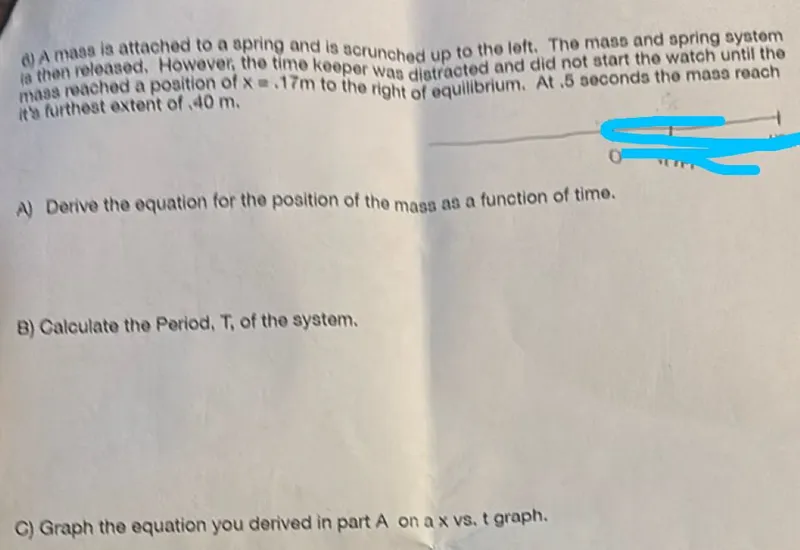A) Derive the equation for the position of the mass as a function of time.
Establish the general equation for simple harmonic motion
The general equation for the position, \( x(t) \), of a mass undergoing simple harmonic motion as a function of time, \( t \), is given by \( x(t) = A\cos(\omega t + \phi) \), where \( A \) is the amplitude, \( \omega \) is the angular frequency, and \( \phi \) is the phase constant.
Determine the amplitude A
The amplitude, A, represents the maximum displacement from the equilibrium position. In this case, the mass reaches its furthest extent of 0.40 m, so \(A = 0.40 \text{ m} \).
Use given conditions to relate the phase constant to time and position.
We're given that at \( t = 0.5 \text{ s} \), \( x = 0.40 \text{ m} \) representing the maximum position where cosine = 1. This simplifies to \( x(0.5) = 0.4\cos(0.5ω + ϕ) = 0.4 \). Simplifying this expression yields \( 1 = cos(0.5ω + ϕ) \). Therefore, \( 0.5ω + ϕ = 0 \), which means \( ϕ = -0.5ω \).
Next, consider the position at time \( t = 0 \) where \( x(0) = 0.17 \text{ m} \). Plugging this value into the general equation gives us \( x(0) = 0.4 \cos(ϕ) = 0.17 \).
Substitute the phase constant.
Substituting \( ϕ = -0.5ω \), the equation now becomes \( x(0) = 0.4 \cos(-0.5ω) = 0.17 \), implying \( \cos(-0.5ω) = \frac{0.17}{0.4} = 0.425 \).
Find the angular frequency.
Since \( \cos(-x) = \cos(x) \), we have \( \cos(0.5\omega) = 0.425 \). Taking the inverse cosine gives \( 0.5\omega = \arccos(0.425) \approx 1.1318 rad \). So, \( \omega = \frac{1.1318}{0.5} = 2.2636 \text{ rad/s} \).
Substitute the angular frequency to solve for \( ϕ \).
\( ϕ = -0.5ω = -0.5 \cdot 2.2636 = -1.1318 \text{ rad} \).
Finalize the equation of motion.
Substituting \( A \), \( \omega \), and \( \phi \) into the general equation, we get: \( x(t) = 0.4\cos(2.26t - 1.13) \).
\( \boxed{x(t) = 0.4\cos(2.26t - 1.13)} \)
B) Calculate the Period, T, of the system.
Relate period to angular frequency.
The period, T, is related to the angular frequency, \( \omega \), by the equation \( T = \frac{2\pi}{\omega} \).
Calculate the period.
Using the calculated angular frequency, \( \omega = 2.26 \text{ rad/s} \), the period is \( T = \frac{2\pi}{2.26} \approx 2.78 \text{ s} \).
\( \boxed{T \approx 2.78 \text{ s}} \)
C) Graph the equation you derived in part A on a x vs. t graph.
Plot the x vs. t graph
The graph will be a cosine wave with an amplitude of 0.4 m, a period of approximately 2.78 s, and a phase shift. The graph would show the position \( x \) on the vertical axis and time \( t \) on the horizontal axis. The cosine wave oscillates between +0.4 m and -0.4 m.
(A sketch of the cosine function described above, with proper axes labels and showing at least one full period, is expected as an answer. However, providing a visual graph is not feasible in this text-based format.)
\( x(t) = 0.4\cos(2.26t - 1.13) \)
\( T \approx 2.78 \text{ s} \)
(A cosine graph with the specified parameters is expected)






